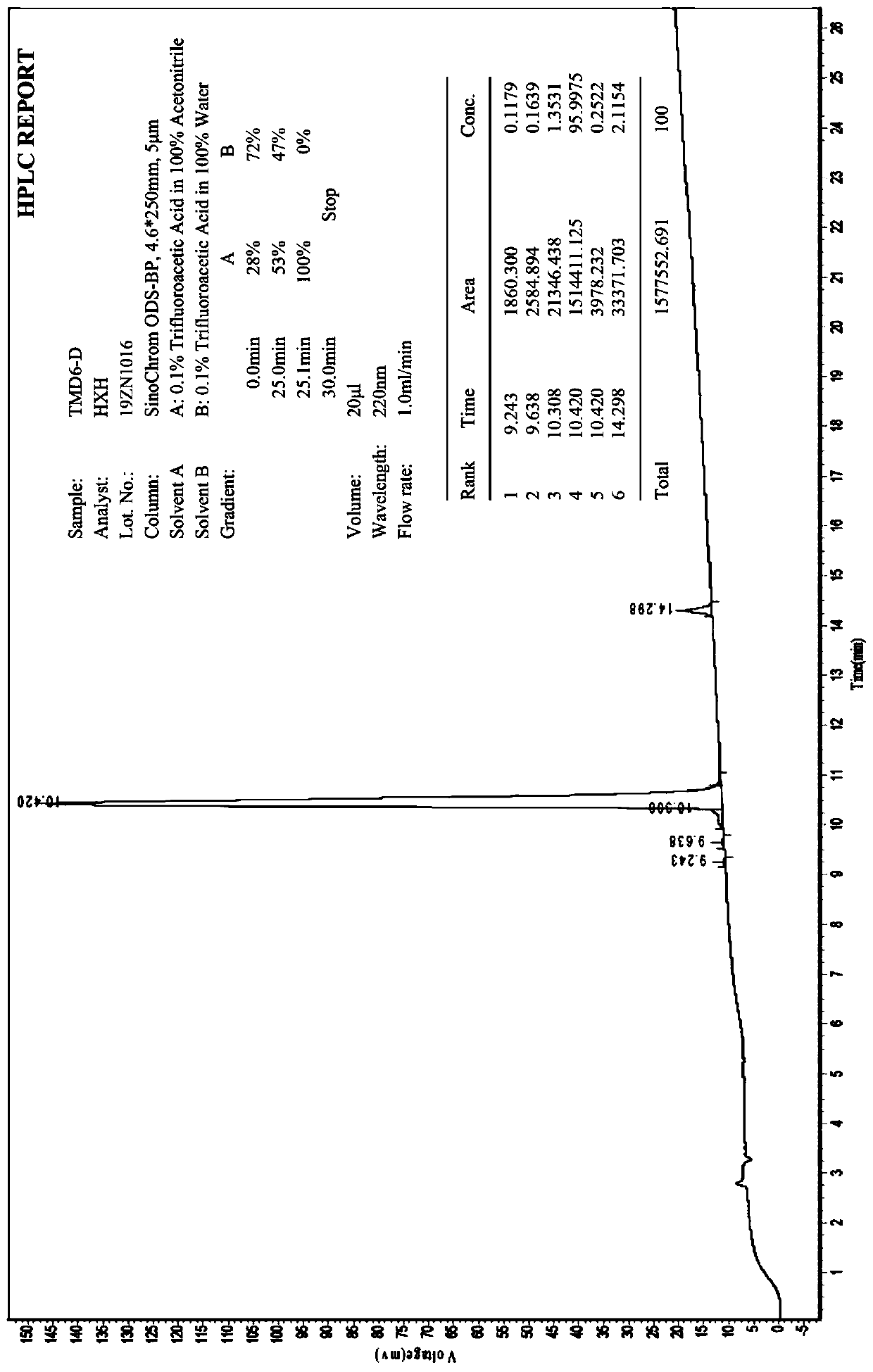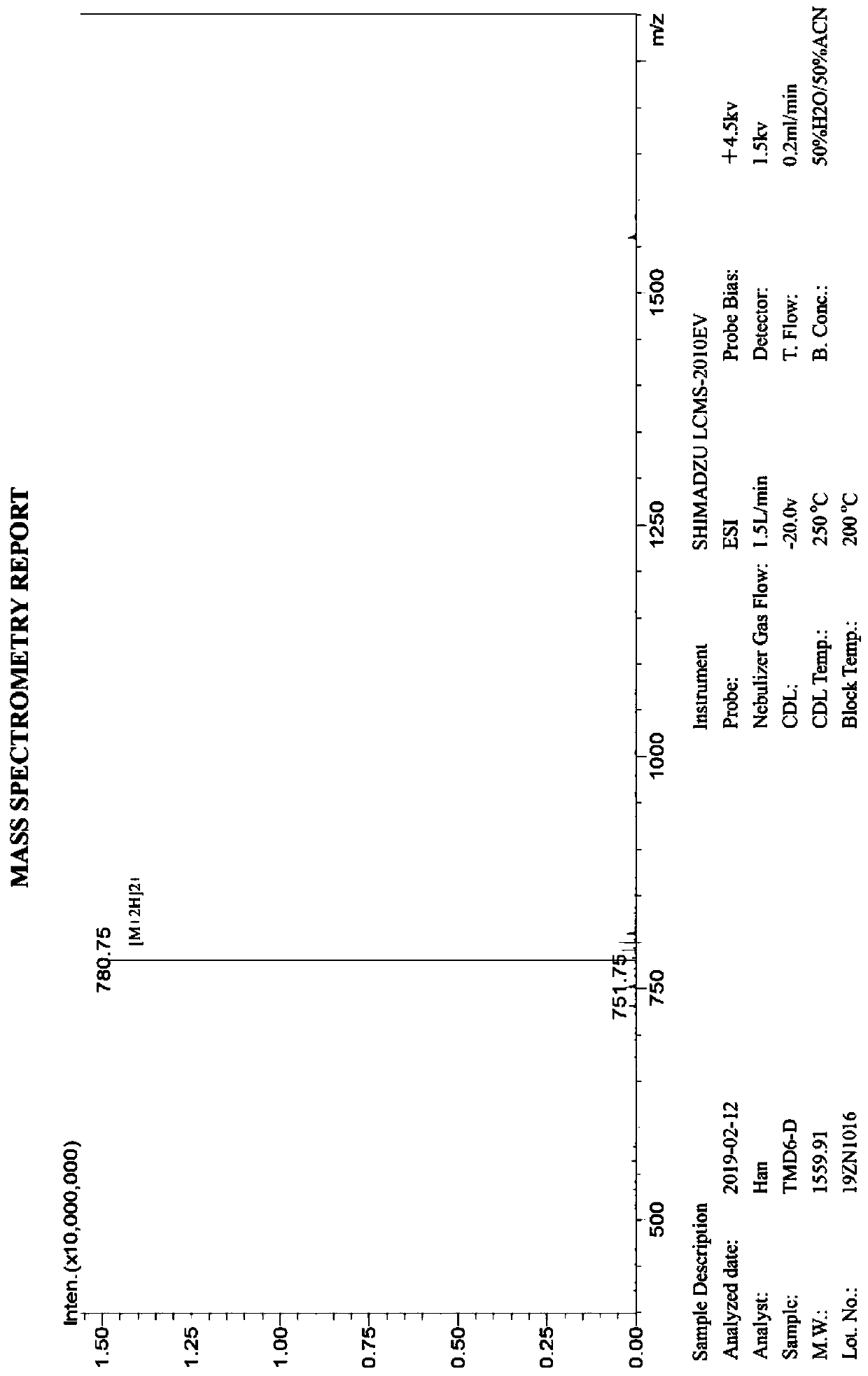Anti-tumor polypeptide with double effects and application thereof
An anti-tumor and anti-tumor technology, applied in the field of biomedicine, can solve the problems of poor prognosis of patients, achieve the effects of short research and development cycle, inhibit tumor cell proliferation, and increase permeability
- Summary
- Abstract
- Description
- Claims
- Application Information
AI Technical Summary
Problems solved by technology
Method used
Image
Examples
Embodiment 1
[0065] The preparation of embodiment 1TMD6-D polypeptide
[0066] Proceed as follows:
[0067] 1. Resin swelling: Weigh 0.6g of CTC resin with a substitution degree of 1.0mmol / g, place it in a reaction tube, add DCM (15ml / g), and shake for 30min.
[0068] 2. Deprotection: Remove DCM, add 20% piperidine DMF solution (15ml / g), shake for 5min, remove piperidine solution, add fresh 20% piperidine DMF solution (15ml / g), shake for 15min.
[0069] 3. Detection: Take out the piperidine solution, take a small amount of resin (about 20 resins), wash it three times with ethanol, add one drop of ninhydrin, KCN, and phenol solution, heat (105-110°C) for 5 minutes, and it turns blue .
[0070] Four. Washing for the first time: wash twice with DMF solution (10ml / g), then wash twice with methanol (10ml / g), and finally wash twice with DMF solution (10ml / g).
[0071] 5. Condensation: Three-fold excess of protected amino acids and three-fold excess of HBTU were dissolved with as little DMF as...
Embodiment 2
[0079] Example 2 Detection of Permeability of Vascular Endothelial Cells in Vitro
[0080] Human umbilical vein endothelial cells (HUVECs) or siRNA-transfected HUVECs (1×10 5 ) were inoculated in 12-well transwell chambers (0.4 micron pore size), and cultured in DMEM (Dulbecco's modified Eagle's medium) medium containing 10% fetal bovine serum (FBS). at 37°C and 5% CO 2 After 48-96 hours of incubation under conditions, when HUVECs formed a mature monolayer of cells and covered the bottom membrane of the upper chamber, the culture solution was aspirated, and serum-free DMEM culture solution was added, and VEGF recombinant protein (50ng / ml) was added, Or eight kinds of polypeptides (the concentration is 25nM), or different concentrations of TMD6-D polypeptides. After incubation for 30 minutes, 50 mg of fluorescein isothiocyanate (FITC)-conjugated dextran (molecular weight 40 kDa, 1 mg / mL) was added to the upper chamber. After continuing to incubate for 30 minutes, the lower c...
Embodiment 3
[0085] Example 3 Detection of tumor tissue permeability in vivo
[0086] Female BALB / c nude mice (6-8 weeks old) received subcutaneous injection of human pancreatic cancer BxPC-3 cells (2×10 6 ), to establish subcutaneous pancreatic cancer tumors. Three weeks later, when the tumor had grown to a diameter of about 1 cm, the animals were divided into three groups (3 nude mice in each group). Control group: inject 1 mg of Evans Blue (Evans Blue) (dissolved in 200 μl of PBS) through the tail vein; positive control group: inject a mixture of 1 mg of Evans Blue and VEGF recombinant protein (400 ng) through the tail vein (dissolved in 200 μl of PBS); TMD6-D group: a mixture of 1 mg of Evans blue and TMD6-D polypeptide (500 μg) was injected via the tail vein (dissolved in 200 μl of PBS). Thirty minutes later, anesthesia was induced by intraperitoneal injection of a mixture of ketamine and xylazine, and circulatory lavage with 1% BSA (bovine serum albumin, bovineserum albumin) (disso...
PUM
 Login to View More
Login to View More Abstract
Description
Claims
Application Information
 Login to View More
Login to View More - R&D Engineer
- R&D Manager
- IP Professional
- Industry Leading Data Capabilities
- Powerful AI technology
- Patent DNA Extraction
Browse by: Latest US Patents, China's latest patents, Technical Efficacy Thesaurus, Application Domain, Technology Topic, Popular Technical Reports.
© 2024 PatSnap. All rights reserved.Legal|Privacy policy|Modern Slavery Act Transparency Statement|Sitemap|About US| Contact US: help@patsnap.com










